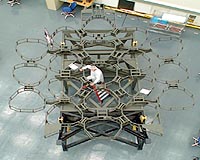 |
Dwingeloo, Netherlands (SPX) Jul 22, 2009 A team of astronomers and engineers at ASTRON, the Netherlands Institute for Radio Astronomy, has successfully detected correlated interferometric radio signals, so-called "fringes", from the sky with the first three, recently completed, full-scale LOFAR stations. The Low Band Antenna (LBA) stations were pointed at Cygnus A, a very powerful radio galaxy associated with an ultra massive black hole. The signals from this galaxy travelled for 600 million years to get here - once the signals were received at the LOFAR stations they started a new and much shorter journey via the fiber network that is connected to the IBM Blue-Gene supercomputer in Groningen. From there, the correlated data were sent to Dwingeloo for final processing. The team observed the entire frequency band from 30 to 78 Mhz at a spectral resolution of 763 Hz. A day later, the experiment was successfully repeated using the High Band Antennas (HBAs) between 120 and 168 Mhz. The stations that were used were between 5 and 20 km apart. Once completed, LOFAR will consist of more than 50 stations distributed across Europe with baselines ranging from 30 m up to 1500 km. Dr. Michiel Brentjens, one of the astronomers at ASTRON: "This may seem quite straightforward, but many things had to go right to get these results. If one element in the chain does not work, you do not get the right data on your screen." According to Brentjens the data quality is superb, much better than expected at this early stage in the telescopes commissioning phase. Prof. Michael Garrett, general director of ASTRON, praised the efforts of his staff, and the contribution of other national and international partners: "This is a major step forward for the LOFAR project. The first results give us a taste of what will follow; we are truly opening up a new window on the early Universe." Share This Article With Planet Earth
Related Links ASTRON Space Telescope News and Technology at Skynightly.com
 Keeping A Trained Eye On The James Webb Space Telescope
Keeping A Trained Eye On The James Webb Space TelescopeGreenbelt MD (SPX) Jul 16, 2009 NASA and Northrop Grumman are keeping a "trained eye" on the James Webb Space Telescope, by training their engineers on how to handle and assemble the telescope's Optical Telescope Element (OTE), also known as the "eye" of the telescope. Recently, a mock-up of the OTE's Primary Mirror Backplane Assembly (PMBA), which supports the telescope's mirror segments, was used to simulate how the el ... read more |
|
| The content herein, unless otherwise known to be public domain, are Copyright 1995-2009 - SpaceDaily. AFP and UPI Wire Stories are copyright Agence France-Presse and United Press International. ESA Portal Reports are copyright European Space Agency. All NASA sourced material is public domain. Additional copyrights may apply in whole or part to other bona fide parties. Advertising does not imply endorsement,agreement or approval of any opinions, statements or information provided by SpaceDaily on any Web page published or hosted by SpaceDaily. Privacy Statement |